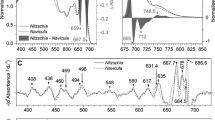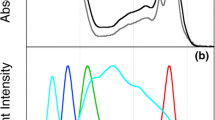Abstract
Algae are continuously exposed to short-term fluctuations in irradiance. We investigate how two red algae species regulate photosynthetic efficiency to cope with such changes and identify some strategies that differ from higher plants. Two red algae, Gracilaria domingensis and Kappaphycus alvarezii, with antheraxanthin and lutein as major xanthophylls, respectively, reacted to the onset of low light (below E k) with a substantial decrease of NPQ. This is different from higher plants, but similar to previous observations in, e.g. cyanobacteria where it indicates an increase in the effective absorbance cross-section of Photosystem II (PSII) by state transition. Kinetic studies in continuous light revealed a high susceptibility of PSII to light stress ((1-q P)/NPQ) in K. alvarezii immediately after the sudden onset of high light, followed by a decrease. This was caused by a slower onset of NPQ in K. alvarezii, followed by acclimation. In G. domingensis, susceptibility of PSII to light stress was stable with time, but absolute values of (1-q P)/NPQ were higher than in K. alvarezii. These observations suggest that K. alvarezii may be better adapted to high light levels, but is less well prepared for large sudden changes in irradiation. In K. alvarezii, photosynthesis continued to increase with increasing irradiation when NPQ was saturated. As (1-q P) and NPQ were still balanced in this situation, most likely, processes other than photosynthetic oxygen release are responsible for the increasing net O2 production observed.




Similar content being viewed by others
References
Andersson M, Schubert H, Pedersén M, Snoeijs P (2005) Different patterns of pigmentation and photosynthesis acclimation in two tropical red algae. Mar Biol (in press)
Asada K (1999) The water-water cycle in chloroplasts: scavenging of active oxygens and dissipation of excess photons. Ann Rev Plant Physiol Plant Mol Biol 50:601–639
Bailey S, Mann NH, Robinson C, Scanlan DJ (2005) The occurrence of rapidly reversible non-photochemical quenching of chlorophyll a fluorescence in cyanobacteria. FEBS Lett 579:275–280
Bilger W, Björkman O (1990) Role of the xanthophylls cycle in photoprotection elucidated by measurements of light induced absorbance changes, fluorescence and photosynthesis in leaves of Hedera canariensis. Photosynth Res 25:173–185
Brown LM, McLachlan J (1982) Atypical carotenoids for the Rhodophyceae in the genus Gracilaria (Gigartinales). Phycol 21:9–16
Campbell D, Öquist G (1996) Predicting light acclimation in cyanobacteria from non-photochemical quenching of PSII fluorescence, which reflects state transitions in these organisms. Plant Physiol 111:1293–1298
Campbell D, Hurry V, Clarke AK, Gustafsson P, Oquist G (1998) Chlorophyll fluorescence analysis of cyanobacterial photosynthesis and acclimation. Microbiol Mol Biol Rev 62:667–683
Choo KS, Nilsson J, Pedersén M, Snoeijs P (2005) Photosynthesis, carbon uptake and antioxidant defence in two coexisting filamentous green algae under different stress conditions. Mar Ecol Prog Ser (in press)
Delphin E, Duval JC, Etienne AL, Kirilovsky D (1996) State transitions or delta-ph-dependent quenching of photosystem II fluorescence in red algae. Biochem 35:9435–9445
Delphin E, Duval JC, Etienne AL, Kirilovsky D (1998) Delta pH-dependent photosystem II fluorescence quenching induced by saturating, multiturnover pulses in red algae. Plant Physiol 118:103–113
Demmig-Adams B, Adams WW (1993) The xanthophyll cycle. In: Young A, Britton B (eds) In Carotenoids in photosynthesis. Chapman & Hall, London, pp 206–251
Demmig-Adams B, Adams WW (1996) Xanthophyll cycle and light stress in nature: uniform response to excess direct sunlight among higher plant species. Planta 198:460–470
D’Haese D, Vandermeiren K, Caubergs RJ, Guisez Y, De Temmerman L, Horemans N (2004) Non-photochemical quenching kinetics during the dark to light transition in relation to the formation of antheraxanthin and zeaxanthin. J Theor Biol 227:175–186
Eickmeier WG, Casper C, Osmond CB (1993) Chlorophyll fluorescence in the resurrection plant Selaginella lepidophylla (Hook. et Grev.) Spring. during high-light and desiccation stress, and evidence for zeaxanthin-associated photoprotection. Planta 189:30–38
Falkowski PG, Raven JA (1997) Aquatic photosynthesis. Blackwell Science, Oxford
Fork DC, Satoh K (1986) The control by state transitions of the distribution of excitation energy transfer in photosynthesis. Ann Rev Plant Physiol 37:335–361
Franklin LA, Seaton GGR, Lovelock CE, Larkum AWD (1996) Photoinhibition of photosynthesis on a coral reef. Plant, Cell Environ 19:825–836
Gantt E (1990) Pigmentation and photoacclimation. In: Cole KM, Sheath KG (eds) Biology of the red algae. Cambridge University Press, Cambridge, pp 203–221
Garcia-Mendoza E, Matthijs HCP, Schubert H, Mur LR (2002) Non-photochemical quenching of chlorophyll fluorescence in Chlorella fusca acclimated to constant and dynamic light conditions. Photosynth Res 74:303–315
Gilmore AM, Yamamoto Y (1993) Linear models relating xanthophylls and lumen acidity to non-photochemical fluorescence quenching: evidence that antheraxanthin explains zeaxanthin-independent quenching. Photosynth Res 35:67–78
Goss R, Böhme K, Wilhelm C (1998) The xanthophyll cycle of Mantoniella squamata converts violaxanthin into antheraxanthin but not to zeaxanthin: consequences for the mechanism of enhanced non-photochemical quenching. Planta 205:613–621
Granbom M (2001) Circadian rhythms and carbon acquisition in the red algae Kappaphycus alvarezii and Eucheuma denticulatum. Doctoral Thesis, Department of Botany, Stockholm University
Green DW, Oliver RL (2003) Using non-photochemical quenching of chlorophyll a fluorescence to access the light climate and growth rate of the cyanobacterium Anabaena circinalis. Eur J Phycol 38:113–122
Henley WJ (1993) Measurement and interpretation of photosynthetic light-response curves in algae in the context of photoinhibition and diel changes. J Phycol 29:729–739
Holt NE, Fleming GR, Niyogi KK (2004) Toward an understanding of the mechanism of non-photochemical quenching in green plants. Biochem 43:8281–8289
Jassby AD, Platt T (1976) Mathematical formulation of the relationship between photosynthesis and light for phytoplankton. Limnol Oceanogr 21:540–547
Krause GH, Weis E (1984) Chlorophyll fluorescence as a tool in plant physiology. II Interpretation of fluorescence signals. Photosynth Res 5:139–157
Krause GH, Weis E (1991) Chlorophyll fluorescence and photosynthesis—the basics. Ann Rev Plant Physiol Plant Mol Biol 42:313–349
Kromkamp JC, Forster RM (2003) The use of variable fluorescence measurements in aquatic ecosystems: differences between multiple and single turnover measuring protocols and suggested terminology. Eur J Phycol 38:103–112
Lohr M, Wilhelm C (1999) Algae displaying the diadinoxanthin cycle also possess the violaxanthin cycle. Proc Nat Acad Sci USA 96:8784–8789
Masojídek J, Kopecky J, Koblizek M, Torzillo G (2004) The xanthophylls cycle in green algae (Chlorophyta): its role in the photosynthetic apparatus. Plant Biol 6:342–349
Maxwell K, Johnson GN (2000) Chlorophyll fluorescence—a practical guide. J Exp Bot 51:659–668
Niyogi KK, Björkman O, Grossman AR (1997) The roles of specific xanthophylls in photoprotection. Proc Nat Acad Sci USA 94:14162–14167
Ögren E. (1991) Prediction of photoinhibition in willow leaves under field conditions. Planta 184:1037–1043
Öquist G, Chow WS, Anderson JM (1992) Photoinhibition of photosynthesis represents a mechanism for the long-term regulation of Photosystem II. Planta 186:450–460
Osmond JB (1994) What is photoinhibition? Some insights from comparisons of shade and sun plants. In: Baker NR, Bowyer JR (eds) Photoinhibition of photosynthesis: from molecular mechanisms to the field. Bios Scientific Publishers, Oxford, pp 1–24
Park YI, Chow WS, Anderson JM (1995) The quantum yield of photoinactivation of Photosystem II in pea leaves is greater at low than high photon exposure. Plant Cell Physiol 36:1163–1167
Pogson BJ, Rissler HM (2000) Genetic manipulation of carotenoid biosynthesis and photoprotection. Philos Trans R Soc Lond B 355:1395–1403
Rakhimberdieva MG, Stadnichuk IN, Elanskaya IV, Karapetyan NV (2004) Carotenoid-induced quenching of the phycobilisome fluorescence in photosystem II-deficient Synechocystis sp. FEBS Lett 574:85–88
Sagert S, Schubert H (2000) Acclimation of Palmaria palmata (Rhodophyta) to light intensity: comparison between artificial and natural light fields. J Phycol 36:1119–1128
Sapozhnikov DL, Krasovskaja TA, Maevskaya AN (1957) Change in the interrelationship of the basic carotenoids of the green leaves under the action of light. Dokl Akad Nauk USSR 113:465–467
Schreiber U, Bilger W, Neubauer C (1994) Chlorophyll fluorescence as a nonintrusive indicator for rapid assessment of in vivo photosynthesis. In: Schulze ED, Caldwell M (eds) Ecophysiology of photosynthesis. Springer-Verlag, Berlin, pp 49–70
Schreiber U, Endo T, Mi H, Asada K (1995) Quenching analysis of chlorophyll fluorescence by the saturation pulse method: particular aspects relating to the study of eukaryotic algae and cyanobacteria. Plant Cell Physiol 36:873–882
Schubert H, Sagert S, Forster RM (2001) Evaluation of the different levels of variability in the underwater light field of a shallow estuary. Helgol Mar Res 55:12–22
Schubert H, Gerbersdorf S, Titlyanov E, Titlyanova T, Granbom M, Pape C, Lüning K (2004) Circadian rhythm of photosynthesis in Kappaphycus alvarezii (Rhodophyta): independence of the cell cycle and possible photosynthetic clock targets. Eur J Phycol 39:423–430
Shen YK, Chow WS, Park YI, Anderson JM (1996) Photoinactivation of Photosystem II by cumulative exposure to short light pulses during the induction period of photosynthesis. Photosynth Res 47:51–59
Starr R, Zeikus JA (1987) UTEX—The culture collection of algae at the University of Texas at Austin. J Phycol 23(Suppl):1–47
Ursi S, Pedersén M, Plastino E, Snoeijs P (2003) Intraspecific variation of photosynthesis, respiration and photoprotective carotenoids in Gracilaria birdiae (Gracilariales: Rhodophyta). Mar Biol 142:997–1007
Van Kooten O, Snel JFH (1990) The use of chlorophyll fluorescence nomenclature in plant stress physiology. Photosynth Res 25:147–150
Wright SW, Jeffrey SW (1997) High-resolution HPLC system for chlorophylls and carotenoids of marine phytoplankton. In: Jeffrey SW, Mantoura RFC, Wright SW (eds) Phytoplankton pigments in oceanography: guidelines to modern methods. Unesco, Paris, pp 327–341
Yamamoto H, Nakayama OM, Chichester CO (1962) Studies on the light and dark interconversion of leaf xanthophylls. Arch Biochem Biophys 97:168–173
Young AJ, Frank HA (1996) Energy transfer reactions involving carotenoids: quenching of chlorophyll fluorescence. J Photochem Photobiol B 36:3–15
Acknowledgements
Financial support from the Sernanders Stiftelse, Uppsala University and the Stockholm Marine Research Centre is gratefully acknowledged. We are grateful to Professor Marianne Pedersén for valuable comments on the manuscript. All experiments comply with the current laws of Germany as well as Sweden. The authors thank Matthew Dring (Belfast) for his very valuable comments on and corrections of the first version of this publication.
Author information
Authors and Affiliations
Corresponding author
Additional information
Communicated by M. Kühl, Helsingør
Rights and permissions
About this article
Cite this article
Schubert, H., Andersson, M. & Snoeijs, P. Relationship between photosynthesis and non-photochemical quenching of chlorophyll fluorescence in two red algae with different carotenoid compositions. Mar Biol 149, 1003–1013 (2006). https://doi.org/10.1007/s00227-006-0265-9
Received:
Accepted:
Published:
Issue Date:
DOI: https://doi.org/10.1007/s00227-006-0265-9




